Genre: Shmup Developer: Hot-B Publisher: Flying Edge Players: 1 Released: 1992
Style is the grand cover-up for which the otherwise unimpressive can be made distinguishable from the mediocre hordes. The plain can be formed to look attractive through the correct application of a unique appearance, which can distract from, or completely overshadow, a number of shortcomings. This is often applied to the world of gaming, where style and pretty visuals take precedence over substance. This is all well and good until one clues in to the gaming wasteland he or she has stumbled into, but sadly by then admission has already been paid and shafted your wallet has properly been. In the case of Steel Empire, a solid shooter has been smartly dressed in stylish enough garb to simply improve what is to begin with a sound enough design naked. The way it should be.
To quote the Steel Empire packaging, “Enter a future that might have been.” The world of Steel Empire is one of flying machines and airborne warfare featuring a 1940s charisma. The player takes on the role of a pilot for the defiant Republic of Silverhead, a force struggling to topple the dominating Motorhead Empire. The Empire has conquered much of the world with their heavily-armed air fortresses and various other machines of unquenchable destructive potential. These will all become your foes as you take on the Steel Empire.
From outward appearance and setting, this does not resemble your traditional horizontal space shooter, although for all extents and purposes it plays as one. There are a few interesting features of the game play that help to prevent your time with Steel Empire from degrading into shooter monotony. For instance, instead of a traditional power-up system with several weapons available through the collection of coloured or numbered pick-ups, your aircraft’s primary fire and secondary fire are upgraded by amassing 3 experience icons to level up your armaments to a maximum of level 20. Other power-ups can be collected, these including speed upgrades, energy recovery items, screen-clearing ‘Lightning Bombs’ that can be hoarded, and a specific collectible that materializes two outrigger planes which hover above and below your craft, operating as additional guns. Your craft also possesses the ability to fire both forward and behind (not simultaneously, mind you), with the two directions corresponding to the B and C buttons.
Before each stage you are offered the choice of either the Striker Airplane or the Z-01 Zeppelin Airship, with your inevitable decision boiling down to fragile maneuverability versus cumbersome fortitude. Both aircrafts can survive multiple hits (naturally the larger zeppelin more than the airplane), with your maximum health upgradeable through the leveling-up previously noted for weapon advancement. For select levels, your choice of aircraft will substantially affect your ability to complete the mission at hand, seeing as several stages in particular favour one vessel’s strengths over the other. Luckily, you are offered a briefing on the level ahead before the choice of aircraft is made, so a general idea of the awaiting obstacles should help steer your better judgment. While both aircraft possess the same standard fire, in addition to this the airplane launches air-to-ground missiles that shred targets below, and the zeppelin belches aerial mines that float on an arc through the sky ahead. Particular boss situations reward the air-to-ground assault, others the mine swarm.
Steel Empire‘s style is achieved through the vintage aircraft designs and the film reel-like presentation the game is given. The title screen and inter-level briefings are delivered with a 1940s movie-projection feel, with flickering light and faded shades of brown making up the palette. Even the game’s ending credits are presented as if they were from a movie, with names credited to positions normally reserved for film production. This presentation is mostly successful and does nothing but enhance Steel Empire’s visual appeal in the face of a subdued in-game colour assemblage and the noticeable presence of both flicker and slowdown during moments of intensity.
The bosses are for the most part creatively dealt with, ranging from heavily-armoured war trains with multiple points of destructibility to various equally-destroyable airborne battleships, and even a stealthy submarine. A serious bout of laziness must have been responsible for the repetition of bosses through several of the stages, which does make for a boring conclusion in each of the levels involved. Rather disappointing.
The seven levels themselves are more or less your standard survive-the-seemingly-impossible-onslaught formula, with one offbeat situation involving an escape from a collapsing mine. The challenge level is at best lukewarm overall, with variation of course depending on the chosen game difficulty. Even then, there should be no serious hurdles preventing a 40-minute completion. Enemy projectiles are clear enough to see, and collision detection is mainly fine. There exist occasional moments during the course of the game that require worming into cramped spaces that can make for possible cheap hits here and there, but luckily, meetings between your aircraft and the level environments do not spell your instant doom. Instead, constant damage is taken until dislodged. In the case of death, a fresh plane or zeppelin is placed under your control and the level continues churning along from your previous location, granted you have the lives to spare.
In terms of audio, Steel Empire is a featureless slab of concrete. Game music is almost entirely forgettable, and the majority of sound effects are drab. This kind of eardrum neglect is unfortunate, because a pumping soundtrack can do so much for a shooter and hearing the impressive rip of an explosion is nearly as satisfying as gazing into the blossoming hellfires that produced it.
To blaze your way through Steel Empire from start to finish is an entertaining experience, if not a particularly repeatable one. It is perhaps worth playing through at least twice, to try each level with the two selectable aircraft, but undoubtedly you will settle on one as your favourite and stick with it against what hints in the level briefings otherwise suggest. I found the “leveling-up” system for weapon enhancement to be restrictive compared to the half-dozen or so individual weapon sets available in most other shooters, but it certainly allows you to think less about which items to collect in the heat of battle. The ability to fire behind your craft makes for superior rear defense and is a very useful feature handled well in Steel Empire. It is an enjoyable enough shooter with a unique feel, and (like many Genesis games of similar quality) worthwhile picking up if found for a sensible price, preferably single digit.
SCORE: 7 out of 10


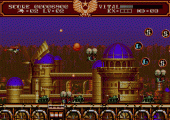
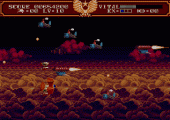
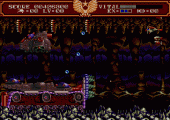
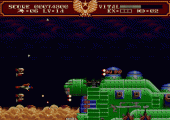
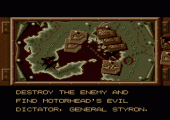
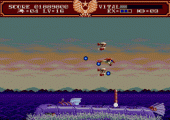
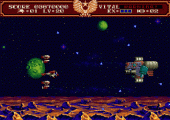
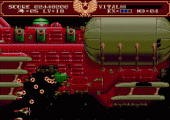
Great game with great imaginative graphics and awesome music, give it a try!